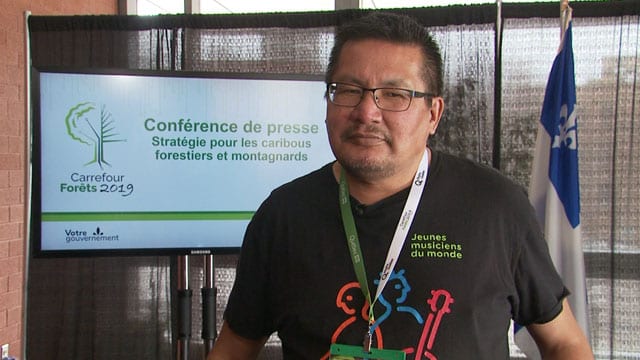First Nations in Quebec are critical of the province’s announcement of another round of consultations to look into the declining Woodland Caribou herd numbers.
Jimmy Papatie is the forestry coordinator for the Anishinabe Nation of Kitcisakik and the former Chief.
“In my career, I have seen numerous conferences organized by the Quebec government on the caribou questions and this government is not any different than the others,” Papatie said.
“In the sense that, what is being done with the Val d’Or caribou right now, is only to keep the [general] population not necessarily very informed on what is happening in the group discussions.”
On Thursday Pierre Dufour, the province’s minister of Forests, Wildlife and Parks announced the launch of public consultations that will begin in 2021 – with a prevention strategy to follow in 2022.
(“… it will take many years, and in a few years, it will most likely be too late,’’ says Jimmy Papatie. Photo: Sophie-Claude Miller/APTN)
Dufour says there are only eight caribou left in the Val d’Or region.
Indigenous communities in Northern Quebec have been consulted already a few times in the past decades about how to protect woodland caribou.
Papatie is wondering how the province’s strategy of consultation is any different than what he’s seen before.
He says he has met the mayor of Val d’Or and the ministers more than once and he was not impressed with this announcement.
“Because when we look at this, they were talking about the partners and there was no Indigenous people in front with them, the Indigenous were absent, ’’ says Papatie.
(Pierre Dufour, left, announced a new strategy to save the Woodland Caribou herd in Quebec City Thursday. Photo: Sophie-Claude Miller/APTN)
APTN News asked Dufour about those previous consultations and how many nations were consulted this time.
‘’The Cree Nation and Madame Jerome from Lac Simon are really concerned about what can be done with the caribou,” Dufour said. “We have to think about it actually, what we going to do exactly for them. But we know them, they want to work with us and that’s the main thing about it.
“I think if we want to have a society project, we need to have everybody together to try to find the way we can do something.‘’
The Indigenous tribes from the region are not the only ones worried about the local woodland caribou herd.
Olivier Kolmel is in charge of the forest campaign at Greenpeace Canada.
‘’It is a little hard to see a “new” element in this ‘’announcement,’’ Kolmel said in a statement. “Overall, the minister always adds delays. Between the designation of caribou as endangered species in 2003 and the protection strategy planned for 2022, a whole generation of caribou will be extinct.”
“Although nothing has changed since the propositions put forward ten years ago.
Melissa Mollen-Dupuis is an environmentalist in charge of the Boreal campaign for the David Suzuki Foundation.
(Mélissa Mollen Dupuis of the David Suzuki Foundation. Photo: Sophie-Claude Miller/APTN)
She feels somewhat hopeful about the consultations.
“So now there is a consultation that has been ongoing since many years with the community I have been hearing that it might be in September 2021, but there is also already ongoing consultation so I was hearing about the Cree nation that is being talked with and also the people from Lac Simon and some communities also up east in the Innu nation,” she said.
“What I might be looking for is more information on different places because there are a lot of projects that are being pushed forward. But I really hope that it’s going to be an engagement, not letting go of the population. Because there are eight caribous that have been counted and I just hope that it’s in regards of increasing the numbers of caribous in the Val d’Or herd.”
Papatie said one of the problems is that the forestry and mining activities were still given permits to operate.
These activities have invaded the woodland caribou’s natural territory.
According to Papatie, the woodland caribou in the Val d’Or area lost nearly 92% of its territory since 1985.
While caribou have long been been an important food source for the Innu and the Cree, the Anishinabe near Val d’Or were forced to stop harvesting them decades ago when the population plummeted.
‘’Today they [the Quebec government] are talking about restoring the caribou population. But they are the cause of this, they are responsible for its disappearance. During the discussions we had with them, they often wrongfully blamed the Indigenous. They said it’s us that kill the caribou, but at home in Kitcisakik, no one kills caribou.
“In Lac Simon as well they don’t kill them. We have measures and we take part in discussions with them and we propose initiatives, ’’ states Papatie.
Not all nations agree with what should be done to protect the woodland caribou, but most agree that they should be consulted and say that it is time to take action before it’s too late.
‘’I would say that in Quebec, there are more herds than in Val d’Or. They might have a chance, but the ones in Val d’Or… We [Kitcisakik Anishinabe] are involved in projects to take the small ones in La Sarre and to reintroduce them in the Val d’Or herd, but we know it will take many years, and in a few years, it will most likely be too late,’’ said Papatie.
Papatie said his people have been telling the province to take action since 1985 when the Val d’Or caribou herd was at fifty.












